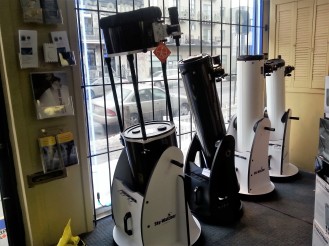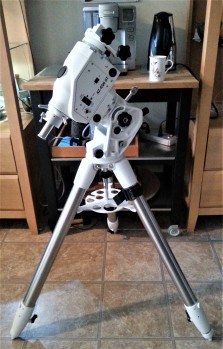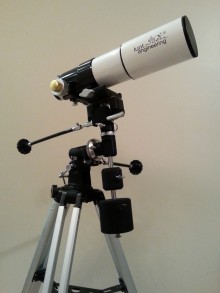The basic purpose of the mount is to hold the telescope. The mount also serves to position the telescope so that it can be centered on objects of interest. In its simplest form, the mount can operate completely manually but with additional computerized components can be made to automate the processes of tracking and object-locating.
Knowledge concerning the types of mounts, the Go To Mount, which is a computerized variation of the basic mount types and familiarization with the concepts of the Celestial Sphere and the Equatorial and Horizon Coordinate Systems would be important to understand.
The Two Types of Mounts
The 2 basic telescope mount designs, the Equatorial and the Altazimuth are discussed below. Numerous variations exist of each but only the most common will be mentioned. The 2 main designs differ essentially in that an equatorial mount has one axis tilted over unlike an altazimuth, so that it points to the celestial pole. These two types of mounts can be used manually or with tracking motors on one or both axis to track an object in the sky automatically. These mounts can further be computerized to find an object in the sky. These are called Go To mounts.
Altazimuth Mount
An At-Az Mount allows for an up-down and left-right movement. The up-down movement changes the instrument’s altitude while the left-right motion changes what’s known as its azimuth. Altitude refers to height above the horizon, and azimuth is the angle along the horizon from north. The mount thus moves parallel and perpendicular to the horizon and is therefore very intuitive. This means that to keep an object in the field of view requires motion in both axes achieved either manually or automatically through the addition of added features.
Consider:
-
Most compact type of mount
-
Eyepiece is always in convenient position
-
Easy to use for terrestrial viewing
-
The movement of the mount is parallel and perpendicular to the horizon, making this type of mount intuitive to point, leaving the eyepiece in a convenient position, and making it well-suited to terrestrial observing.
-
Unlike the equatorial mount, no balancing or polar alignment required.
However:
-
it makes tracking objects in the sky more difficult manually; automatic tracking is possible with a computerized mount.
-
Must be mounted equatorially (using a wedge) in order to be used for imaging to prevent field rotation.
The Dobsonian Mount

Skywatcher Dobsonian Mount
The Dobsonian mount is a modified version of the Altazimuth mount. This mount was invented in the 1970’s by John Dobsonian. Dobsonian mounts are mounted on the ground by a heavy platform, and designed to support massively sized newtonian reflectors. Essentially the dobsonian is a very large tube reflector mounted on a fork mount that pivots. Dobsonian telescopes can have very large apertures ranging from 6 to 36 or more inches.
Dobsonian mounts typically are adjusted manually to track celestial objects. This involves manually moving the telescope “up-and-west” as the object rises, and “down-and-west” as the object sets in an arc. Manual tracking is easier than with a standard refractor or reflector because the Dobsonian telescope has a very wide field of view so the object stays in the field of view longer requiring less frequent manual adjustments.
Using a Dobsonian is the easiest of all setups. Simply point the telescope and look. The movement is very intuitive since it is just up-down, left-right. The fluid motion allows for easy tracking of objects as Earth rotates. Many Dobsonians are now computerized as well for the purposes of automatic tracking or finding an object.
Consider:
-
Least expensive of all mount and telescope systems.
-
Dobsonian mounts typically are adjusted manually to track celestial objects. This is easier than a standard refractor or reflector because the Dobsonian telescope has a very wide field of view. Another benefit of the wide-field is that as objects move across the sky they will stay in the field of view longer simply because the Dobsonian scope reveals so much of the night sky even at higher magnifications
-
Easy to setup, no balancing or polar alignment needed.
However:
-
The Dobsonian mount does not automatically track the sky as Earth rotates. For observational astronomy constantly having to manually track an object makes it difficult at a star party when many people are viewing using the same telescope. The solution would be a tracking device which could be bought with or later added to the Dobsonian setup.
-
The Dobsonian mount is not recommended for astrophotography because it is very difficult to continuously aim the telescope precisely. However the reflector could be taken off the Dobsonian mount and placed on an equatorial mount for the purposes of tracking and imaging or alternatively a tracking added to the Dobsonian setup.
Equatorial mounts are designed to follow the motion of the sky. This is especially useful since the rotation of the earth can cause objects to quickly move out of view. Equatorial mounts are often configured with motorised drives which match the rotation of the Earth. This makes it easier to observe sky objects for longer periods of time. There are two basic types of equatorial mounts, the German Equatorial and the Fork.
The Equatorial Mount

Skywatcher AZ Neq6 Mount
Both Newtonian Reflectors and Refractor telescopes normally use this type mount. The German Equatorial mount’s distinguishing feature is the large counterweight extending on the opposite side from the telescope which provides balance to the system. It is set up so that the entire system rotates around the Celestial Pole. The mount only has to move the telescope in Right Ascension as time goes by to “track” objects rising in the East and setting in the west. This means only one motor is required (the RA motor), although a Declination motor is often supplied as well just to make pointing the telescope to new objects easier. Motors on one axis or both axis will allow you to observe without readjusting the scope.
In order to ensure the rotation axis of the mount is precisely aligned with the rotation axis of the Earth a procedure called Polar Alignment has to be done. Essentially this involves initially pointing the mount to face North on the compass and adjusting the altitude (Declination) on the mount to correspond to the latitude of the region where you live. Finally, a more precise polar alignment is done with the help of a small “polar-alignment telescope” which is often built right into the axis of rotation of the mount. The North Star is used as the alignment object for the Celestial Pole. Alternatively, if the mount does not have a separate polar-alignment scope, then the main telescope or its “finder scope” can be used.

Equatorial Mount (not motorized)
Equatorial telescopes come with setting circles the purpose of which is to allow the user to manually position the telescope by using a coordinate system. Theoretically it is possible to position the scope using the angular markings on the circles, and then to track a target by manually turning the RA knob. However in practice, the diameter of the setting circles would have to be about 8 inches to be able to render a precise positioning of an object.
Consider:
-
Because the distance from the main axis of the mount to the telescope is shorter in a German equatorial mount than a fork mount (especially for larger instruments) there is less possibility of flexure, making the telescope more solid and less prone to vibration. The counterweights keep the entire assembly balanced around a central point, increasing stability.
-
Another advantage of the German equatorial mount is versatility. Unlike a fork mount, various instruments can be interchanged on a German equatorial mount. This allows multiple telescopes to be used with a single mount.
-
German Equatorial Mounts can be relatively heavy primarily due to the extra mass of the counterweights. However greater weight of the mount contributes to greater stability which is important in observational astronomy and essential in astrophotography.
-
The German Equatorial Mount breaks down into more smaller pieces than a fork-mounted system, and so the individual weight of components will lend itself to greater portability.
However:
-
A German equatorial mount is more expensive than a Fork Mount but generally with price comes quality. More expensive mounts track more precisely and are more stable.
-
Setting up a German equatorial mount is more time consuming. There are more components to assemble. Also, the mount must be balanced and polar aligned every time it is used.
-
A German Equatorial Mount cannot track through the meridian. It must be flipped from east to west as the target being tracked crosses from one side of the sky to the other. For observational astronomy this is normally not a an issue. With regard to astrophotography, if timed right, running into the meridian is also not usually an issue. However, for the purposes of tracking an object in an uninterrupted fashion, across the meridian, the Fork Mount is be better suited.
-
The overall weight and setup time are greater than with other types of mounts.
-
To understand and use the equatorial mount requires a good deal more skill and conceptualization than with other mounts. However, mastering all the skills is not initially required to begin enjoying and using a telescope with this type of mount.
The Fork Mount
A Fork mount, depending on the model, can run in either the altazimuth mode or equatorial mode:
Fork Mount -Altazmuth Mode
Newer models of Fork Mounts are computerized with motor drives in both axes, and are most often used in the altazimuth configuration. With these computerized instruments, the altazimuth mode is a fully functional star tracking configuration for observational purposes. The computer constantly adjusts the speed of the two motors to keep the telescope pointed at a particular object.
Fork Mount- Equatorial Mode
A Fork Equatorial mount holds the telescope on the end of one or two arms. An equatorial wedge can be added to a fork-mounted telescope so that it will function as an equatorial mount allowing it to track in the Ra axis.
Consider:
-
An equivalent sized German Equatorial Mount will have less vibration and flexure.
-
The range of motion of the eyepiece of most fork-mounted scopes is very short as well, making it easy to set the telescope at a convenient height for sitting to observe or for sharing the view with others.
-
Polar alignment is not necessary (or possible) so another alignment procedure must be used to ensure the pointing accuracy of the two motors is set properly.
-
Fork mounts are also very easy to set up. In alt-azimuth mode there are only two components, and assembly involves putting the scope/mount onto the tripod. The orientation of the tripod and telescope is unimportant. No polar alignment is required.
-
Fewer components are required than a German equatorial mount. Setup time is easily half or less than that of a German equatorial mount.
-
Another advantage is versatility. Unlike most German equatorial mounts, a fork mount can be quickly converted from alt-azimuth mode for visual observing to equatorial mode for photography using an equatorial wedge.
-
The German equatorial mount requires balancing the telescope and polar aligning to be done for either viewing or imaging. The Fork Mount in equatorial mode requires these steps to be done only for astrophotography.
-
Another potential advantage for photography is that fork equatorial mounts can track through the meridian uninterrupted, unlike a German Equatorial Mount which has to be flipped from east to west when the target crosses from one side of the sky to the other.
-
A fork mount whether in the equatorial mode using the equatorial wedge or in alt-azimuth mode is extremely easy to use with regard to the eyepiece always being in a convenient position for observation.
-
Most Catadioptric and other shorter optical tubes use this style mount, which is generally more convenient to use than the German mount, especially for astrophotography.
However:
-
Comparatively, the distance from the main mount axis to the telescope is shorter on a German Equatorial Mount than a fork-mount. For this reason, a German equatorial mount tends to be more stable than a fork mount, especially for larger-sized instruments.
-
Although the total weight of an equivalent-sized Fork Mount is lighter than a German Equatorial Mount it is less stable. Also, the individual components are heavier. For example, the forks and optical tube are usually a single component, making portability a possible factor to consider.
Web Site Map:
Astronomy Notebook
The Moon
Images And Videos
Equipment and Setup
Notes on Equipment
Astrophotography
An Overview Of The Methods In Astrophotography
Links
Contact
Thanks to: La Maison de l’Astronomie and Lire La Nature Astonomie Plus, for allowing images to be taken of some of the mounts on this page